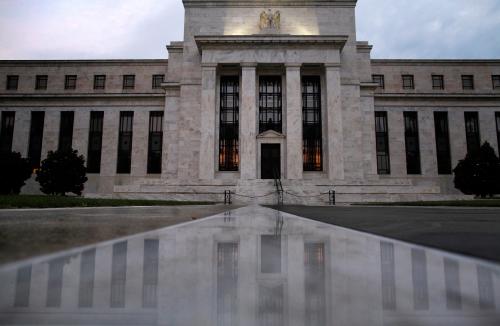When asset prices fall and financial market volatility rises, monetary policymakers face a dilemma. An interest rate cut would reduce downside risks to the economy and support economic growth. But it could also fuel risk taking, leading to higher asset valuations, more leverage, and other buildups of financial vulnerabilities, raising future risks. So when is the right time for monetary easing in response to tightening financial conditions and how can policymakers communicate this choice?
A promising way to measure and communicate such tradeoffs is by employing a measure of financial stability risks called Growth-at-Risk (GaR).[1] GaR gauges possible bad future macroeconomic outcomes from financial conditions and financial vulnerabilities. Specifically, GaR is the 5th percentile of the distribution of forecasted real GDP growth conditional on current growth, inflation, and financial variables.[2] It focuses attention on the lower tail of the distribution of forecasted growth – outcomes that could include a recession – because the lower tail is more sensitive to financial conditions and financial vulnerabilities than the upper tail. In addition, there is a term structure for GaR that indicates an intertemporal tradeoff for risks to GDP growth when financial vulnerabilities are high. That is, while looser financial conditions can reduce the risks of weak growth in the near-term, such as four quarters ahead, they may significantly increase these risks further in the future if the financial sector is not resilient, and adverse shocks force firms to deleverage and fire sale assets.
We use the GaR framework to interpret the financial stability implications of recent changes in financial conditions. Financial conditions had tightened notably late last year– including a sharp drop in stock prices – in part because of higher risks to U.S. growth from weaknesses abroad — and became less supportive of growth. By mid-February, as stock prices rebounded and volatility compressed, financial conditions had fully reversed the tightening in late 2018 (Figure 1), and moved back to being very accommodative by historical standards, near levels of the mid-2000s and mid-1990s.
The loosening of financial conditions resulted in an improvement in GaR, indicating the risks of very weak growth outcomes fell. Figure 2 shows the distributions of forecasted real GDP growth for four quarters ahead based on financial conditions at the end of 2018 and as of mid-February. Note that the GaR in mid-February (in orange) when financial conditions were looser suggests a better outcome for the economy than when financial conditions were tighter at year-end 2018 (in blue); the orange dot in Figure 2 is to the right of the blue dot. That is, the loosening of financial conditions since year-end 2018 significantly reduced the left skewness – the chances of bad outcomes — in the distribution of forecasted growth four quarters ahead. Forecasted median real GDP growth also rose (moved to the right on the chart) with looser financial conditions, but the increase in the forecast of median real GDP growth is smaller than the increase in GaR (the 5th percentile). In other words, the median forecast for four quarters ahead improved only a little, while the chances of very weak growth declined more.

Looser financial conditions, however, may also affect the distribution of expected growth beyond four quarters because such conditions can create incentives for greater risk-taking and increase vulnerabilities in the financial system. To evaluate whether current looser financial conditions have increased financial stability risks in the medium term, we forecast the distribution of real GDP growth out 12 quarters. As shown in figure 3, GaR (the 5th percentile of the distribution) is higher over the forecast quarters for the looser financial conditions (orange line) than when financial conditions were tighter at the end of 2018 (blue line). We interpret the upward shift in the term structure of GaR as an indication that looser financial conditions reduced downside risks for the full projection horizon even beyond four-quarters ahead, although the gains are smaller (and the standard errors are larger) further out the projection horizon.

These estimates are conditioned on the U.S. not currently being in a credit boom. Growth of total nonfinancial credit-to-GDP and for nonfinancial businesses (eight-quarter moving average), shown in Figure 4, are not at high levels relative to historical standards. While there has been rapid growth in leveraged loans and debt ratios for some businesses are high, making them highly vulnerable to weaker growth or a rise in interest rates, credit for the business sector overall has been growing only moderately faster than GDP. It does not suggest that the economy is in the midst of a broad-based credit boom. More broadly, as the Federal Reserve reported in its February 2019 Monetary Policy Report and in its November 2018 Financial Stability Report, and the IMF in its April 2019 GFSR, U.S. financial vulnerabilities overall are not materially elevated. Asset valuations are higher than historical averages and liquidity mismatch for corporate bond and loan funds has increased. But the banking sector has more capital and liquidity, financial sector short-term funding risks are reduced, and bank lending standards do not suggest over-exuberance.

However, if credit boom conditions or other financial vulnerabilities were to become significant, a similar loosening of financial conditions would suggest much greater downside risks to growth in the medium term. Credit boom conditions, an indicator in our model for high financial vulnerabilities more broadly, could arise if market participants were to expect that monetary policymakers would always loosen in response to bouts of market volatility and came to believe they would be protected from severe losses, and, accordingly, become more willing to increase leverage. Substantial loosening of financial regulations also could contribute to an increase in financial vulnerabilities. To illustrate the effects of high financial vulnerabilities, Figure 5 shows the hypothetical term structure of GaR if the economy were in a credit boom given current loose financial conditions (dashed line). Conditional on loose financial conditions and a credit boom, GaR would be higher in the near-term (risks of weak growth are lower) but significantly lower in later quarters, indicating a substantial increase in risks of weak growth over that longer projection horizon. For example, GaR estimates for forecast quarters 7 and later are estimated to be 0 percent or lower growth, which can be interpreted as the probability of negative growth at those quarters is 5 percent or more (since GaR is the 5th percentile). That is, if there were a credit boom, there would be a significant tradeoff between a reduction in downside risks to GDP growth in the near term and increased downside risks two and three years later.

By linking current financial conditions and current measures of financial vulnerabilities to downside risks to growth in the future, the GaR framework is a way to assess and communicate the effects of loose financial conditions to future financial stability risks, which can be used by both monetary policymakers and financial regulators. To date, there has not been a rigorous way to estimate financial stability risks and translate them to meaningful macroeconomic variables that policymakers can use. We believe this framework is a step forward and should continue to be developed and enhanced.[3]
This framework offers some implications for policymaking although more research is needed on the determinants of financial conditions and financial vulnerabilities. First, while monetary policymakers can consider financial stability risks, financial stability need not be a new separate mandate. Rather it is measured as a downside risk to its output (employment) target, and risks to output growth is already part of its objective function. Second, policymakers will want to consider how monetary policy may interact with financial policies to affect financial conditions and financial vulnerabilities; when vulnerabilities are high, loosening financial conditions would substantially increase the risks of bad outcomes in the following couple of years.
In summary, current GaR estimates for the U.S., using existing methods which will continue to be refined, suggest that the recent loosening of financial conditions has reduced downside risks to economic growth in the near term, and, conditional on current financial vulnerabilities, has not increased future risks to financial stability. The challenge for monetary policymakers and macroprudential regulators will be to continue to monitor and ensure that financial vulnerabilities do not become significantly elevated and thereby increase risks to financial stability in the medium-term, especially as loose financial conditions provide incentives for them to build.
[1] Adrian, Tobias, Federico Grinberg, Nellie Liang, Sheheryar Malik (2018), “The Term Structure of Growth at Risk,” Brookings Hutchins Center Working Paper #42, Aug. https://www.brookings.edu/wp-content/uploads/2018/08/WP42-NL-updated.pdf, and International Monetary Fund WP 18/180, Aug 2018; Adrian, Tobias, Nina Boyarchenko, and Domenico Giannone (2019), “Vulnerable Growth,” American Economic Review (forthcoming).
[2] Real GDP growth forecasts are from quantile regressions of real GDP growth on current real GDP growth, inflation, financial conditions, growth in nonfinancial credit, and credit boom (the interaction of loose financial conditions and high credit-to-GDP growth). Quantile regressions differ from least squares because they compute different regressions for various percentage points of the distributions to get a more complete characterization of the data. For this exercise, we used the Chicago Fed financial conditions index, although we use an alternative index in the working paper to be more comparable to what is available for 21 other countries. Results for the U.S. are not materially different with the two alternative indexes (Adrian, Grinberg, Liang, Malik, 2018).
[3] We have expanded GaR beyond the U.S. and estimated GaR for 22 countries, 11 AEs and 11 EMEs, and found the general pattern of an intertemporal tradeoff for risk. We continue to test the GaR estimates and methodologies. For the U.S., the GaR estimates have good out-of-sample forecast properties, and we are testing the forecast properties for other countries. Moreover, we are trying to evaluate financial vulnerabilities other than those based on credit-to-GDP growth. But current estimates reported here are robust to many different specifications.
The Brookings Institution is committed to quality, independence, and impact.
We are supported by a diverse array of funders. In line with our values and policies, each Brookings publication represents the sole views of its author(s).






Commentary
How Growth-at-Risk can help central bankers gauge financial stability risks
April 11, 2019